Disclosure: This post may contain affiliate links. I may earn a small commission for my endorsement, recommendation, testimonial, and/or link to any products or services from this website.
Prepare this traditional rich, hearty Irish Stew recipe on the stovetop or in the slow cooker for a flavorful comfort food dinner! Perfect for a St. Patrick’s Day celebration or for a regular Sunday supper, the classic combination of lamb or beef with vegetables and potatoes in a Guinness or red wine sauce is always a crowd-pleasing dish. Add a crusty loaf of bread, Irish soda bread, cornbread, or biscuits for a simple and satisfying meal.
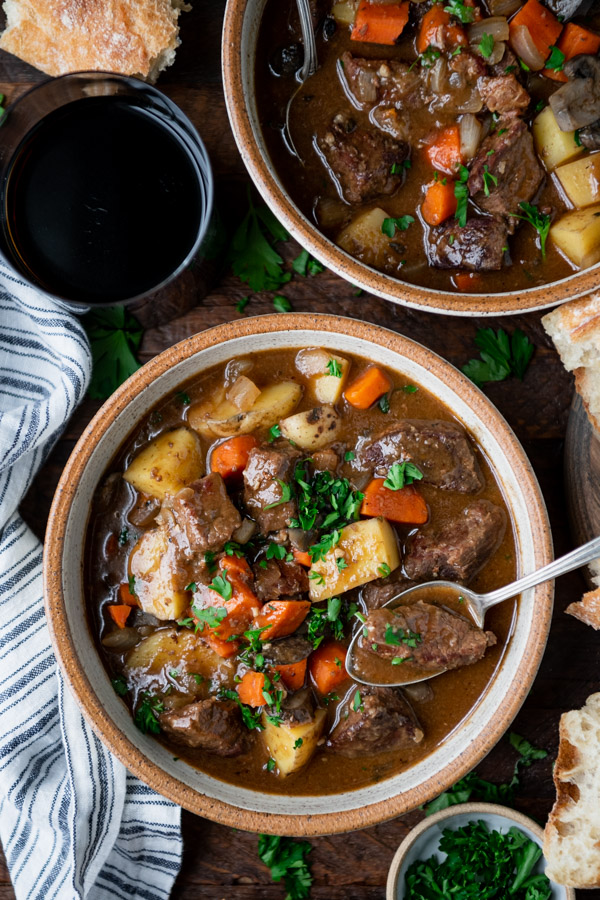
Table of Contents
Looking for other great St. Patrick’s Day recipes? Try this easy Guinness chocolate cake with cake mix, sheet pan cabbage potatoes and sausage, and this dump-and-bake corned beef and cabbage, too!
What’s Irish Stew?
So what makes Irish Stew Irish? Traditional Irish stew originated in Ireland and was made with lamb (or mutton) and root vegetables. Recipes vary by chef and region, but basic ingredients in an Irish stew include the meat, along with potatoes, onions and parsley. Some versions also use carrots, turnips, or barley.
Mutton was the primary ingredient in traditional Irish stew recipes because the Irish culture valued sheep for their wool and milk, and therefore only used older animals for cooking. Irish stew dates back to the early 1800’s, so this is a long-standing classic that we have now adapted for modern American culture as well.
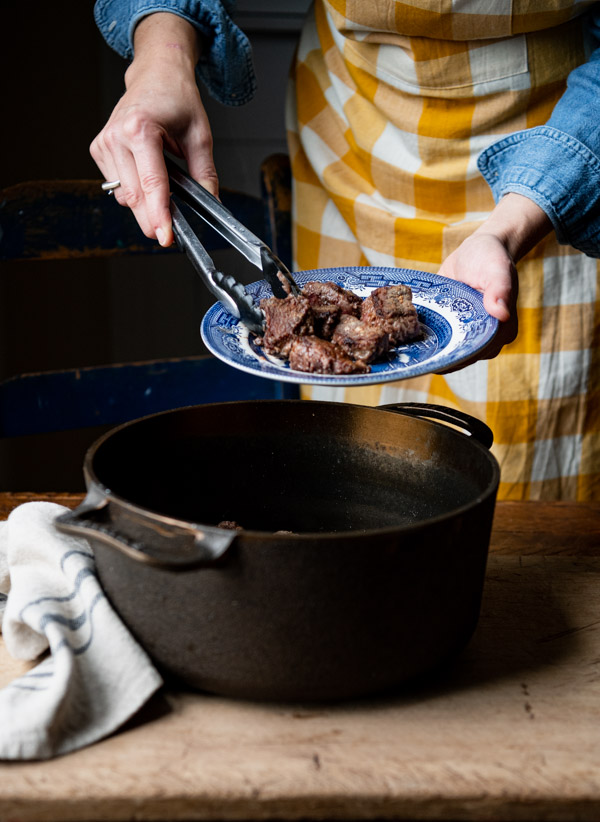
The recipe yields a rich, hearty stew that’s full of succulent, tender meat and perfectly cooked (not mushy) vegetables, all coated in a thick gravy. It’s warming, comforting and ideal for a cold night!
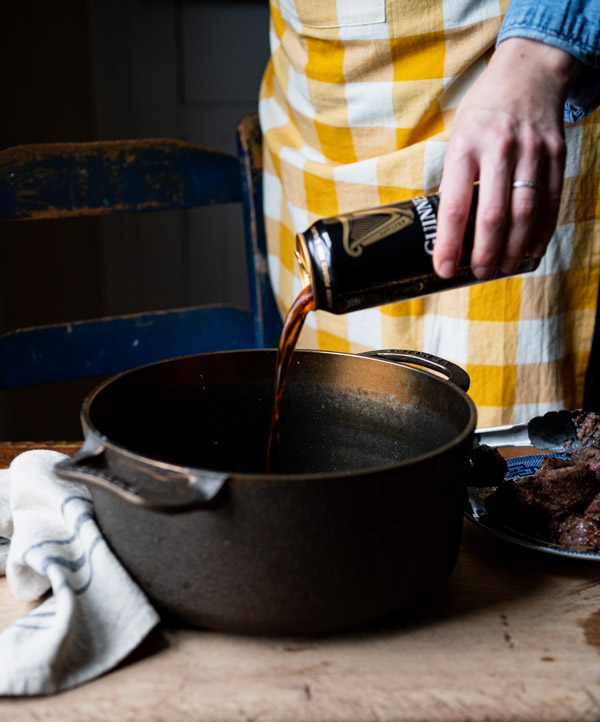
Ingredients
This is a quick overview of the ingredients that you’ll need for a pot of Guinness Irish stew. As always, specific measurements and complete cooking instructions are included in the printable recipe box at the bottom of the post.
- Butter: to brown the meat.
- Bacon: adds a rich, smoky flavor to the dish.
- All-purpose flour: coats the meat, which helps it brown, and also thickens the broth.
- Stew meat: mutton or lamb stew meat are most traditional, but you can also use beef stew meat in this recipe.
- Guinness stout or red wine: use the classic dark Irish beer for extra flavor in the broth, or substitute with a dry red wine such as pinot noir, merlot, shiraz, or cabernet sauvignon. For an alcohol-free dish, use extra beef broth instead.
- Tomato paste: adds tomato flavor in the background and thickens the broth slightly.
- Brown sugar: a hint of sweetness balances the bold, savory ingredients in the stew.
- Garlic, thyme, bay leaf, and paprika: all add savory flavor to the stew.
- Kosher salt and ground black pepper: enhance the other ingredients in the pot.
- Beef broth: the liquid base that braises the meat.
- Onions, carrots, potatoes, and mushrooms: vegetables that add great flavor to the stew and bulk up the meal.
- Fresh parsley: brightens up the rich stew.
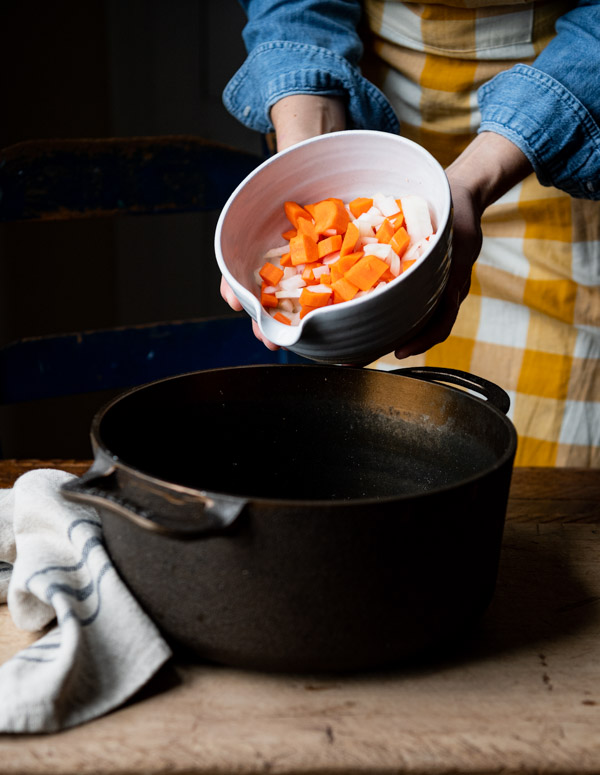
How to Make Irish Stew
I prefer a stovetop Irish Stew, because it gives me more control over the timing of adding the vegetables (and therefore their texture in the finished dish). If convenience wins out and you’d rather make this stew in the slow cooker, I’ve included those instructions below. Either way, every bite is loaded with flavor and comfort. Let’s get started with the best Irish Stew recipe ever!
- Fry the bacon in butter in a Dutch oven. Remove the bacon to a plate.
- Dredge the meat in seasoned flour and brown in the butter and bacon drippings. This adds delicious flavor to the stew! You’ll probably need to work in batches so that you don’t overcrowd the meat in the pan. You don’t want it to steam, but instead you want it to get some nice rich color on the outside.
- Remove the meat to a plate.
- Add the Guinness (or wine) and use a wooden spoon to scrape up any browned bits from the bottom of the pot.
- Return bacon and meat to the pot, along with the tomato paste, brown sugar, garlic, salt, pepper, thyme, bay leaf, paprika, and beef broth.
- Bring the mixture to a boil, then reduce the heat to a low simmer.
- Cover and cook, stirring occasionally, until the meat is tender (about 1 ½ hours).
- Add the onions and carrots; cook for 10 minutes.
- Stir in the potatoes and mushrooms, and cook until the potatoes are fork tender, about 30 more minutes.
- Discard the bay leaf, stir in the parsley, and season with additional salt and pepper, if necessary.
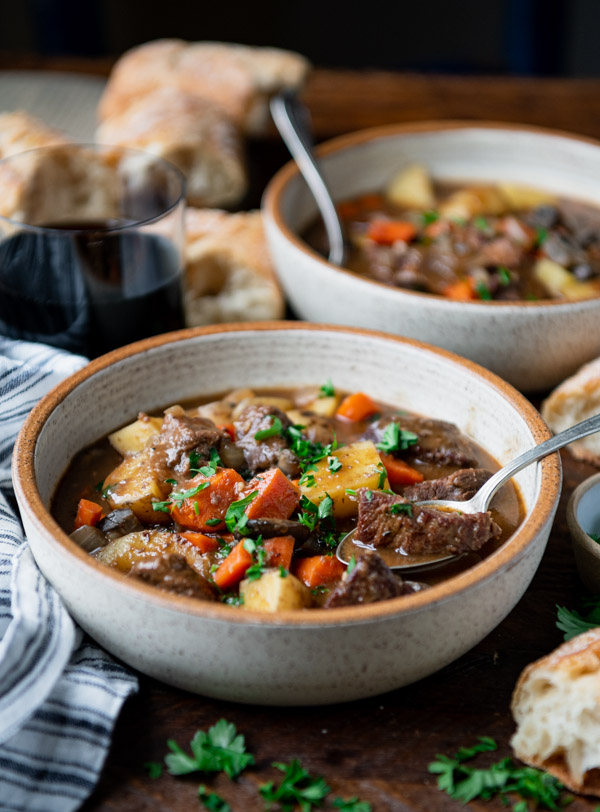
How to Make Irish Stew in a Slow Cooker
While it’s not my preferred method, you can also make this stew in a slow cooker. After browning the meat in a skillet or pot as instructed, transfer all of the browned meat to a Crock Pot. Stir in the remaining ingredients (except the parsley), cover, and cook on LOW for about 6-8 hours or on HIGH for about 3-4 hours.
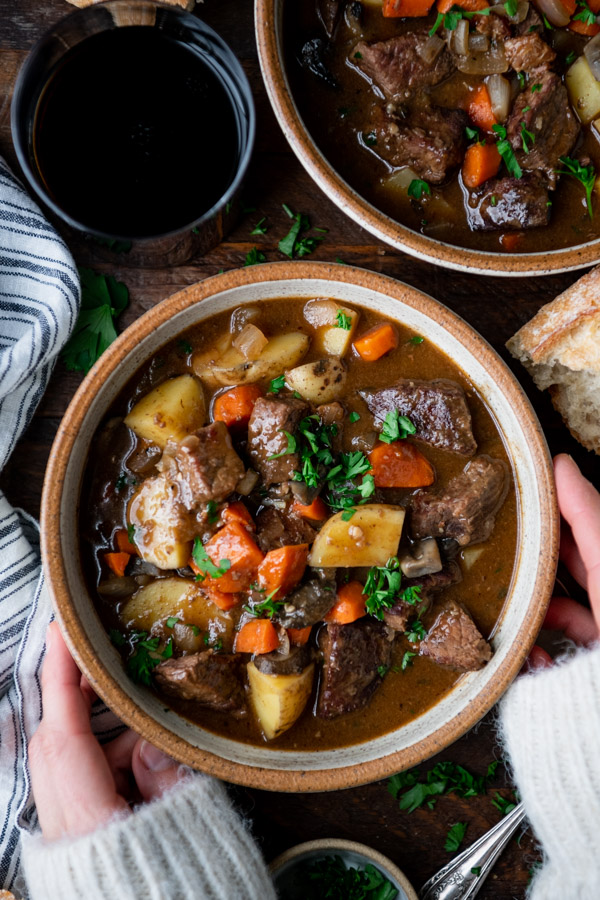
What to Serve with Guinness Irish Stew
With meat, potatoes, and veggies, you’ve basically got an entire meal in one pot — no sides necessary! That said, if you’d like to offer extra options, here are a few ideas:
- Irish Soda Bread
- Noodles
- Buttermilk biscuits, French baguette, a crusty loaf of Dutch oven bread, flaky biscuits or skillet cornbread
- Southern collard greens
- Green salad with red wine vinaigrette or a classic Caesar salad
- Roasted broccoli
Since you’re using Guinness stout in the Irish beef stew, don’t forget a glass of Guinness on the side, too! This dish also pairs nicely with a glass of red wine. A shiraz or a cabernet sauvignon would both be great — you certainly don’t need anything fancy for this rustic meal.
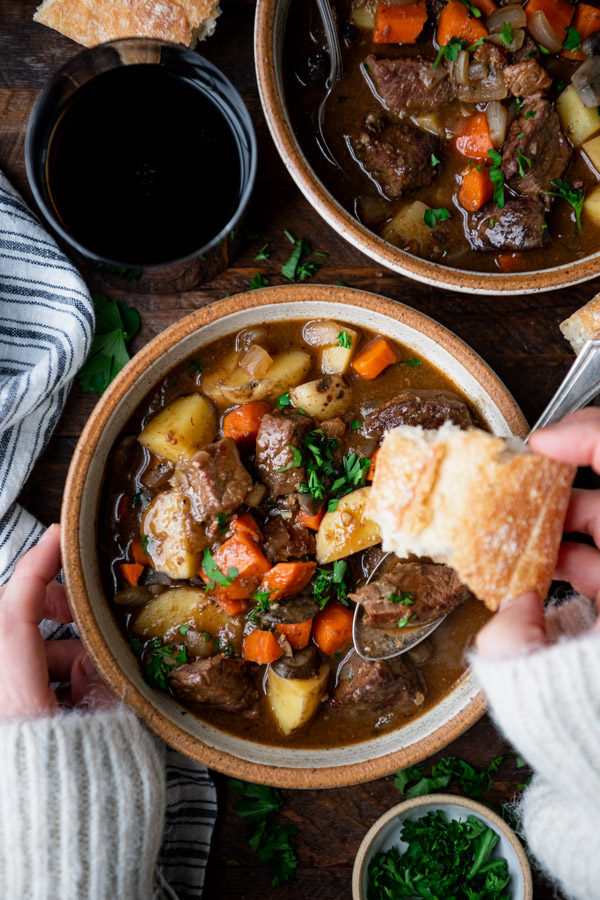
Is Irish Beef Stew healthy?
This dish is loaded with nutritious vegetables, and can be a healthy, filling option. The recipe is not gluten-free, thanks to the flour that you use for dredging the meat.
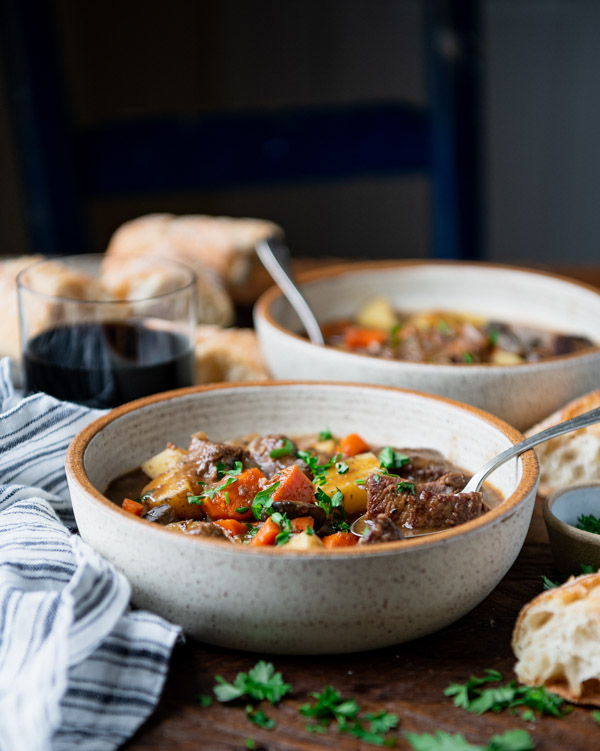
Storage
- Make Ahead: Prepare the stew up to 1 day ahead, let it cool to room temperature, cover with the lid, and refrigerate overnight. Reheat the pot on the stovetop just before serving.
- Freeze: Let the stew cool to room temperature, then refrigerate. Once chilled, transfer the mixture to a resealable container and freeze for up to 3 months. Thaw in the refrigerator overnight.
- Reheat: When chilled, the fat from the stew will rise to the top and harden. You can use a spoon to scrape off most of the fat, or you can simply leave it in the pot and stir it back into the dish when it heats up. Place the cooked stew in a saucepan or Dutch oven on the stovetop. Cover and warm over low heat, just until the stew reaches the desired temperature.
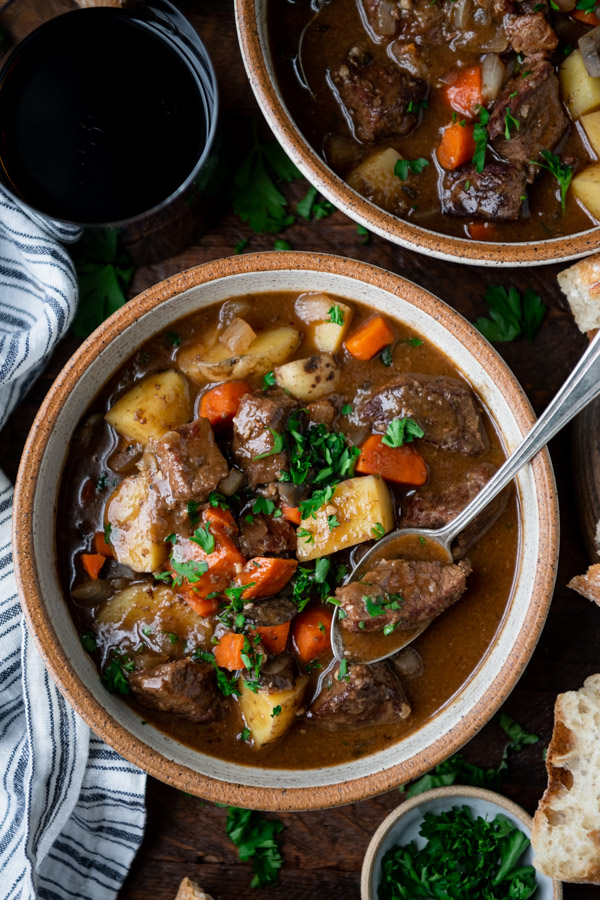
Recipe Variations
- Instead of the Guinness beer, use a dry red wine such as cabernet sauvignon, shiraz, merlot, or pinot noir.
- For an alcohol-free stew, use extra beef broth as a substitute for the Guinness.
- A splash of Worcestershire sauce would be a nice addition to the gravy.
- Herbs to put in Irish stew: I’ve used sprigs of fresh thyme and parsley, which are classic savory herbs to pair with a rustic beef or lamb dish. If you’d like even more herb flavor in your stew, try adding rosemary, too.
- The mushrooms are one of our favorite ingredients in this stew; however, if you don’t care for mushrooms, you can substitute with frozen peas or some chopped cabbage.
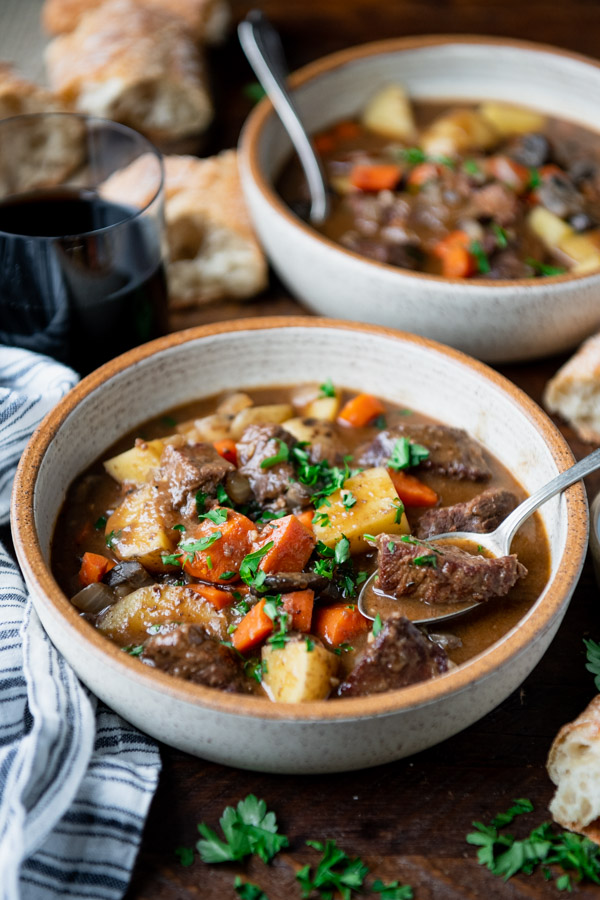
Tips for the Best Irish Stew Recipe
- Use lamb or beef in this recipe. The recipe calls for lamb stew meat, which is a generic term for various cuts of lamb that are suitable for long, slow cooking. Lamb stew meat is generally diced shoulder, neck fillet, shank, or breast. For a leaner cut, diced leg also works well.
- If using beef instead of lamb, look for pre-diced beef stewing meat as a shortcut. Alternatively, you can dice your own chuck roast or brisket at home to use in this recipe.
- Whether you’re using a Dutch oven or a slow cooker, don’t skip the step of browning the meat. Dredging the meat in flour helps to thicken the stew, and it also creates a flavorful crust on the meat and insulates the meat from the high heat in the pan. This step adds so much flavor to the stew — especially if you scrape the browned bits from the bottom of the pot as you deglaze the pan and the broth simmers.
- To make the stew tender, it’s important to cook the meat long enough to break down the tough connective tissue and fibers. If your meat is still tough after about 90 minutes, simmer the stew a little bit longer.
- Keep the Dutch oven covered while simmering in order to trap moisture in the stew. You should end up with the perfect ratio of thick, rich gravy by the end. If you find that the stew is too thick at the end of cooking, just add an extra splash of broth until it reaches the desired consistency.
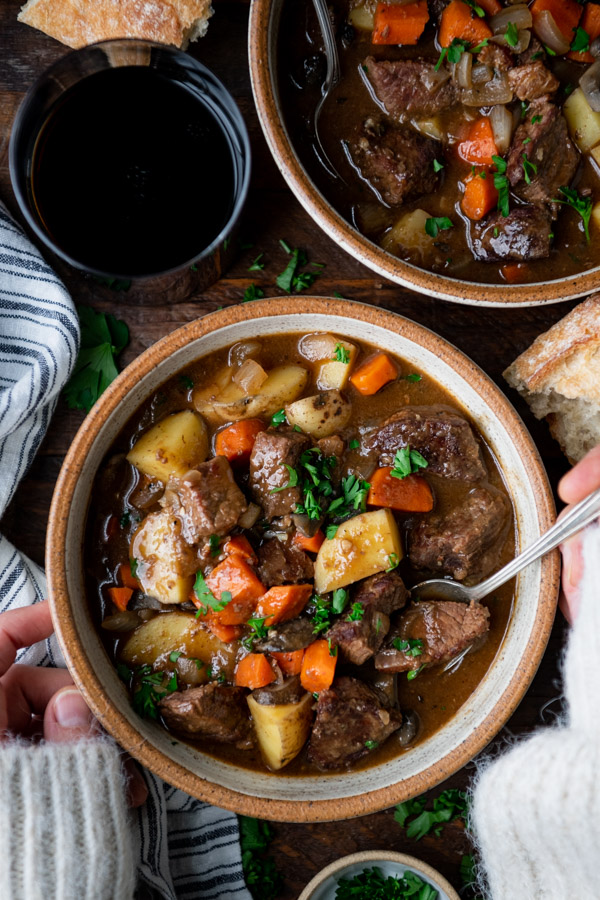
More Easy Stew Recipes to Try
- Beef Burgundy
- Dutch Oven Beef Stew
- Frogmore Stew {Lowcountry Boil}
- Farmhouse Slow Cooker Beef Stew
- Chicken Stew
- Autumn Harvest Pork Stew
- Oyster Stew
- Virginia Brunswick Stew
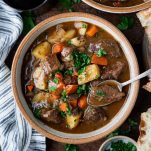
Irish Stew
Ingredients
- 1 tablespoon butter
- 4 slices bacon, chopped
- ½ cup all-purpose flour
- 2 lbs. lamb stew meat or beef stew meat, cut into 1-inch cubes
- 1 cup Guinness stout or dry red wine
- 1 tablespoon red wine vinegar
- 1 tablespoon tomato paste
- 1 tablespoon brown sugar
- 1 tablespoon minced fresh garlic
- 1 ½ teaspoons kosher salt, divided
- 1 teaspoon black pepper, divided
- Leaves from 2 sprigs fresh thyme (or 1 teaspoon dried thyme)
- 1 bay leaf
- ½ teaspoon paprika
- 2 ½ cups beef broth, plus more as needed
- 2 large onions, chopped
- 4 large carrots, peeled and chopped
- 1 ½ lbs. new potatoes, quartered (or use russet potatoes, peeled and chopped into ¾-inch cubes)
- 8 ounces sliced fresh mushrooms
- 2 tablespoons chopped fresh parsley, plus extra for garnish
Instructions
- In a large oven-safe pot or Dutch oven, sauté bacon in butter over medium heat until crisp and browned (about 3-5 minutes). Remove bacon with a slotted spoon and set aside.
- Pat lamb (or beef) dry with a paper towel.
- Place the flour in a bowl or large Ziploc bag and season with about ½ teaspoon of kosher salt and ½ teaspoon of pepper. Add the meat and toss to coat well. Remove coated meat from the bowl and discard any extra flour.
- Sear meat in the butter/bacon fat until browned on all sides (about 5 minutes). Depending on the size of your pot, you may need to work in batches so that the meat can brown without overcrowding.
- Remove the meat from the pot and add the Guinness (or wine) and vinegar. Cook over medium-high heat, scraping the pan with a wooden spoon to loosen any browned bits.
- Add bacon and meat back to the pot, along with the tomato paste, brown sugar, garlic, remaining 1 teaspoon of kosher salt, remaining ½ teaspoon of pepper, thyme, bay leaf, paprika, and broth. Stir really well to completely combine. Bring to a boil; then reduce to a low simmer.
- Cover and cook, stirring occasionally, until the meat is tender, about 1 ½ hours. Add the onions and carrots and simmer, covered, for 10 minutes. Add the potatoes and mushrooms and simmer until vegetables are tender, about 30 minutes more. Add more broth at the end to thin the stew, if necessary. Discard bay leaf; stir in parsley, and season with salt and pepper, to taste. Ladle into bowls and serve. Garnish with additional fresh parsley, if desired.
Notes
- Use lamb or beef in this recipe. The recipe calls for lamb stew meat, which is a generic term for various cuts of lamb that are suitable for long, slow cooking. Lamb stew meat is generally diced shoulder, neck fillet, shank or breast. For a leaner cut, diced leg also works well.
- If using beef instead of lamb, look for pre-diced beef stewing meat as a shortcut. Alternatively, you can dice your own chuck roast or brisket at home to use in this recipe.
- Whether you’re using a Dutch oven or a slow cooker, don’t skip the step of browning the meat. Dredging the meat in flour helps to thicken the stew, and it also creates a flavorful crust on the meat and insulates the meat from the high heat in the pan. This step adds so much flavor to the stew — especially if you scrape the browned bits from the bottom of the pot as your stew simmers.
- To make the stew tender, it’s important to cook the meat long enough to break down the tough connective tissue and fibers. If your meat is still tough after about 90 minutes, simmer the stew a little bit longer.
- Keep the Dutch oven covered while simmering in order to trap moisture in the stew. You should end up with the perfect ratio of thick, rich gravy by the end. If you find that the stew is too thick at the end of cooking, just add an extra splash of broth until it reaches the desired consistency.
Nutrition
This recipe was originally published in February, 2020. It was updated in February, 2022.

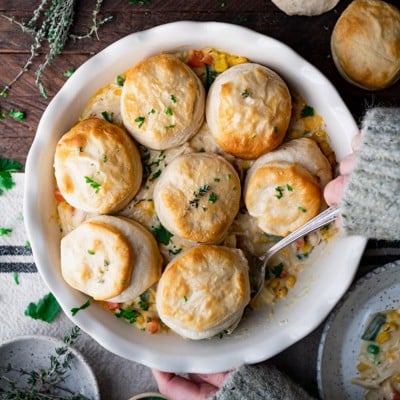
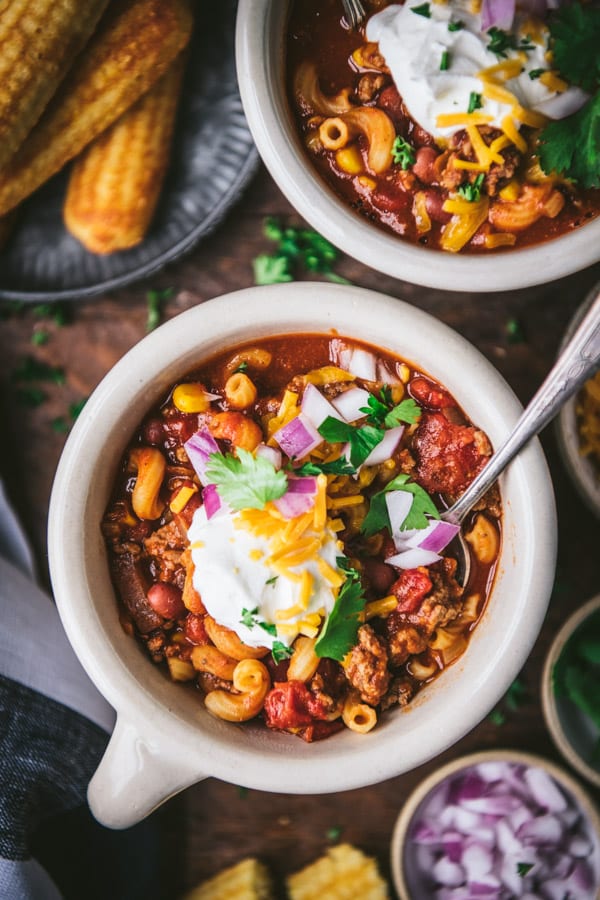
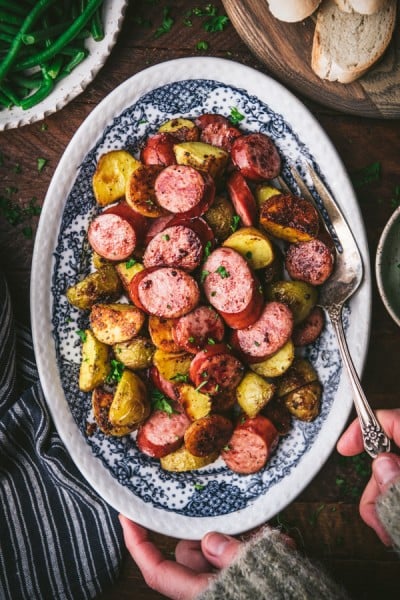








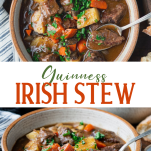
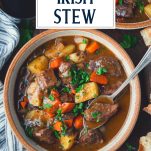
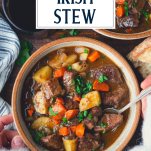
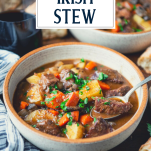
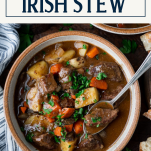
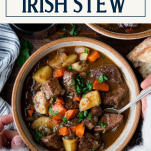
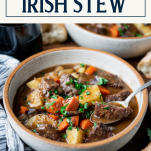
The best stew I have ever made! The meat was so tender, and the veggies were soft but not mushy. I used a bottle of Guinness and a combination of chicken broth and beef broth to get the right amount of liquid. Thank you for always having the best recipes!
That’s so good to hear, Kathryn! Thanks for taking the time to come back here and let me know. Happy almost St. Patrick’s Day! 🙂
Followed the recipe and sauted the beef first – then cooked everything in my pressure cooker for 30-minutes. Did a natural release for 10 minutes. OMG – what a fantastic meal. Served it with crusty French Bread to sop up the great gravy. Thanks for posting.
Thank you, Kathi! I’m so glad that it worked well in the Instant Pot, too. 🙂
I made your Irish Stew recipe a year ago and came back now to change the number of servings as it is for a large group and needed to add more….BUT you have changed your recipe – added bacon and tomato paste etc. Do you prefer this version or why the change? I served the old version to 150 people and scared to change it up!
Hi, Ellen! Yes, I think this version is much more flavorful and even better. 🙂 That said, I’m happy to send you the original version if you’d prefer to use that. I’ll send it to your email and you can choose which one you make! Hope your guests enjoy the stew!
Thank You …………I will try the new version or do a combination maybe!! Thanks for the quick reply!!
No problem, Ellen! 🙂
I just made this Irish Stew yesterday with great success. I did use lamb, and the only changes I made were to add barley instead of mushrooms, and to cook it in my slow cooker for over 10 hours (simply because I had to work). The stew turned out AMAZING!!!! My son gave it the highest compliment: “One of the best things you’ve ever made, Mom.” Thank you, Blair!!
Oh, that’s great to hear, Patricia! I’m so glad that it was a hit, and that your son approved, too. Thanks for letting me know!
This was fabulous! I used beef and it came out so tender and full of flavor! I did it in a cast iron Dutch oven on the stove top. It was worth the trip to the store to buy the Guinness!
I’m so glad that you liked it, Annie. Thanks for your note!
I made this with venison the first time I made it and couldn’t stop eating it, it was so good! Now I’m making it with beef for a New Year’s Eve dinner we go to. I use wine instead of Guinness and my own paprika that I make with thyme and rosemary from my garden. It is one of my very favorite soups/stews.
We’re so glad you enjoy it, Reid!
Blair, I love this recipe. It’s flawless. I do have one suggestion (not altering your recipe). I found that I can use a tough cut of meat and as a short cut, I cut into stew meat the night before and sprinkle a little baking soda on the meat and really incorporate it – like I would with a little salt. The baking soda helps break down the protein in the meat and can reduce overall cooking time. I do the same with tougher cuts of steak. I add baking soda to a marinade and let the meat marinate for at least an hour. The result is a really tender piece of meat!
But back to your recipe – it is now requested by all our friends.
Thanks so much, Barbara. I appreciate your tip, and I’m really happy to hear that you enjoy the stew. Thanks again for taking the time to leave a note!
Made this for my boyfriend, he poo-pooed the idea of Irish stew, made this for him. He loves it, asked me to make it again. Thank-You, this is a great meal has everything in it. Flavor, herbs, spices, vegetables, meat. Just a great recipe>!!!
We’re so happy to hear it was a hit! Thank you for trying it out, Terry.
This looks really scrummy! But I am coeliac. I will use gluten-free flour AND change the Guinness for red wine, as the Guinness has gluten in it. I cannot wait to try it out! Thanks for the recipe!
We hope you enjoy it, Jacqueline!